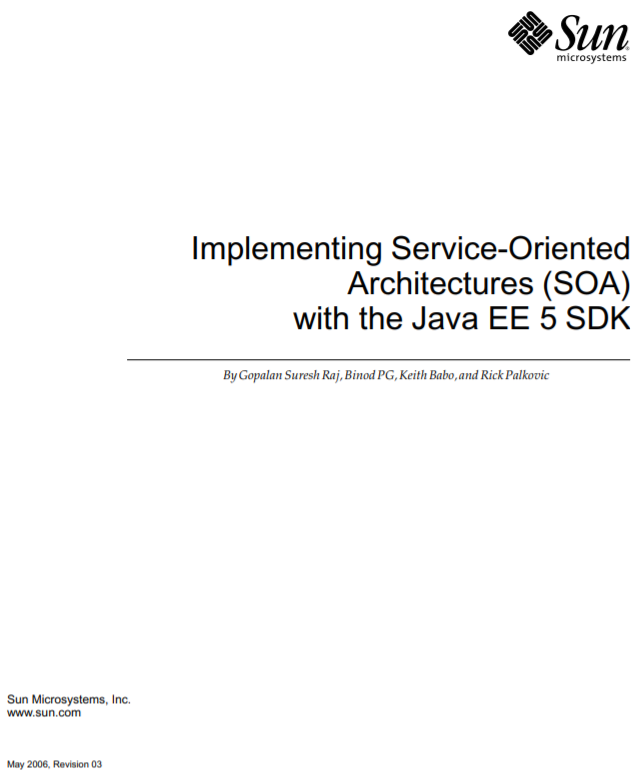Technical Publications-Whitepapers-Implementing Service-Oriented Architectures (SOA) with the Java™ EE SDK
01 May 2006Publications, SOA-Blueprints, The-Web-of-Services, WS-BPEL
Download and Read the Full whitepaper (PDF) from here.
Overview
Service-oriented architecture (SOA) describes a category of composite applications composed of service provider and service consumer components. SOA segregates business logic and offers location transparency for the service providers and consumers.
The SOA approach lets you replace or upgrade individual components in the application without affecting other components or the process as a whole. Moreover, you can independently specify alternative paths through which the components in the application exchange messages.
This whitepaper presents architectural concepts and language constructs necessary to developing a SOA composite application in Java EE. It then presents an example application, deployed in the Java Business Integration (JBI) environment. The example uses HTTP/SOAP binding components and WS-BPEL and Java EE service engines, illustrating how these components can be orchestrated to solve a business problem.
More about the Whitepaper
This whitepaper presents concepts and language constructs needed to develop a Service-Oriented Architecture composite application in Java EE. It then describes an example application designed to solve a business problem.
Why do I need to know this?
The good news is that you don’t need to know any of this to use Java Business Integration(JBI). Perhaps the even better news is that JBI is tightly, seamlessly, and transparently integrated with the GlassFish Application Server. However, we thought some people might be interested in learning how this actually works behind the scenes.
SOA developers who are the users of the Java EE Tools Bundle therefore only need to use domain concepts and technologies related to the business problem they are addressing because JBI and the GlassFish Application Server provide that Invisible Plumbing that makes it easy for the SOA developer. This allows the composite application developer to concentrate exclusively in domains he is expert in, and leaves the business of weaving the services he writes into the overall SOA fabric to the Java EE tools bundle.
Download and Read the Full whitepaper (PDF) from here.
About the Authors
Gopalan Suresh Raj
Gopalan Suresh Raj is a member of Sun’s Research and Architecture team. His expertise spans multi-tier Enterprise Component Architectures and Distributed Object Computing. For the past 15 years, Gopalan has been designing solutions with Java and C++. He is the author of many books and articles on Java technology.
Binod P.G.
Binod P.G. is a staff engineer in the Sun Java System Application Server development team. In addition, he shares ownership of the open source Generic RA for JMS project. He is a member of JDBC expert group and is the maintenance lead of the Connector specification. He has been designing and developing enterprise class products for the past 10 years.
Keith Babo
Keith Babo focuses on enterprise integration architecture for the Java platform as a staff engineer in Sun’s Java Web Services division. He is a member of the JSR 208 Expert Group and an active contributor to the 208 Reference Implementation and to the OpenESB project.
Rick Palkovic
Rick Palkovic is a staff writer for Sun Developer Network. He has written about SunOS and Java technologies for longer than he likes to admit, composing everything from man pages to technical white papers.
